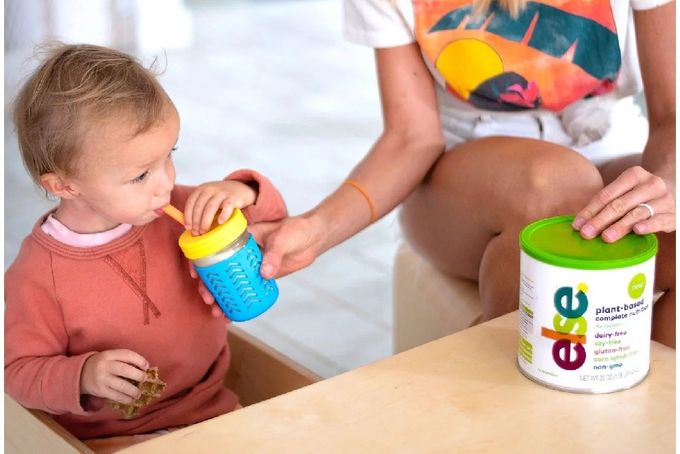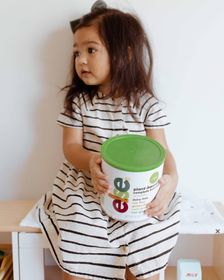From Bottle To Cup: Helping Your Toddler Make the Switch
Are you struggling to get your infant off the bottle? Follow our guide for practical advice and insightful tips to ease the transition.
Updated May 10, 2024

Toddlers become pretty attached to their bottles. They use it for comfort, security, and nourishment. Therefore, getting them to make the transition from a bottle to a sippy cup can be more complex than we initially thought.
Here’s the catch: toddlers aren’t the only ones who resist this natural transition. Sometimes, parents play an equal part in this emotionally challenging process.
The mama bear in you will instinctively come to the rescue when anything is uncomfortable or upsets your little one. While the process may be hard for both of you, it’s a necessary transition for your child to move to the next stage of life healthily.
Why Is It Important To Wean Your Toddler off the Bottle?
Prolonged Use Can Lead to Tooth Decay
The American Academy of Pediatrics recommends switching from bottle to cup at around 12 to 18 months. Since toddlers have a habit of drinking milk at night and falling asleep without brushing their teeth, using the bottle for longer than necessary can lead to “bottle tooth decay.” When your child is sleeping, the production of saliva slows down, and the milk doesn’t get washed away as it should. This creates an acidic layer on the tooth's enamel, increasing toddlers’ risk of tooth decay.
Can Make Your Toddler a Picky Eater
At 12 months, toddlers should eat a variety of foods from the family menu and no longer base their diet on liquids as they did in the first year. If you give them a choice, they may prefer and reject other nutritious, age-appropriate meals.
May Make Them Anemic
Milk has no iron. This means increased milk intake isn’t doing much to meet all your toddler’s nutritional needs. In fact, the calcium in cow's milk tends to block the absorption of iron by the body, further increasing the extent of iron deficiency.
How does this happen? If children drink too much cow’s milk, you may notice reduced body growth. Even if they’re eating veggies and fruits, they can’t utilize most of the iron they consume. This can contribute to anemia.
Can Lead to Infections
When your child lies down to drink milk from a bottle, the liquid pools at the base of the throat. The milk can then travel through the tube that connects the throat to the middle ear. This can become a breeding ground for bacteria, resulting in an ear or throat infection.
As you can see, there are many good reasons to wean children off the bottle at the appropriate time. Now that we know why it’s important to do so, it’s time to explore how you can wean your toddler from bottle-feeding.
How Do I Break My Toddler's Bottle Habit?
Breaking your toddler's bottle habit can be challenging, but it can be done in a way that entails minimal stress for you both. Employing these tips and tricks may help discourage children from drinking from the bottle and direct their attention towards a more attractive option—the cup.
1. Reduce the Number of Bottle-Feedings
Going from bottle to sippy cup doesn’t have to happen all at once. You can make the transition gradually. It may take time, but it usually produces better results than withholding the bottle in one go.
Here’s an example of how you can introduce the change slowly: if your baby drinks from the bottle two times a day, start by eliminating the afternoon bottle and replacing it with table food.
Remember, nighttime bottle-feeding should be the last to go since it offers your baby the most comfort and security. After giving your baby an evening bottle, follow up with tooth brushing. This helps make the routine less comfortable and enjoyable over time. As you progress with the weaning-off process, you may come to a point where you can eliminate bedtime feeding without much fanfare.
2. Dilute the Milk with Water
This is one of the oldest tricks in the book. Start with a 50:50 ratio of milk to water. Slowly but steadily increase the water ratio until the bottle is all water. This will make bottled milk unappealing to your toddler, and your child will naturally gravitate towards tastier whole milk from the cup.
» Explore milk and dairy alternatives for babies and toddlers
3. Be Encouraging and Use Positive Reinforcement
Praise your child and shower them with love, hugs, and attention as they make the switch. Try saying things like, “You’re a big boy/girl now, so you can use a cup like Mommy,” or “You’re a big kid now; don’t you want to try drinking from the cup like Mommy?” This will prepare your toddler for the change.
Toddlers tend to repeat actions that make their parents happy. This need to please will work in your favor when you’re weaning them off bottle-feeding. So praise your toddler every time they drink from the sippy cup. You can applaud the action, give extra playtime, or sing a favorite lullaby as a reward.
4. Make the Transitional Cup Interesting
If your toddler stubbornly clings to its feeding bottle, you may want to say something along the lines of, “The bottle fairy came to our house when you were sleeping and took all your bottles for little babies who need them. But look, they left these really amazing sippy cups with your favorite cartoon!”
They may not be very accepting of the new addition to their feeding schedule, but once they get attracted to “big boy/big girl cups” with colorful straws and designs, they’ll be much more willing to make the transition.
You can even take your toddler to the store with you to choose a cup. This will build excitement towards the bottle-to-cup change.
5. Adopt the Out of Sight, Out of Mind Approach
Keep the bottles out of sight and out of reach. If your toddler doesn’t see the bottle, they aren’t likely to ask for it. This can help speed up the transition.
Remember, the pace at which they get used to drinking from cups depends on you. Don’t give in to temptation whenever your toddler cries for the bottle or throws a hissy fit. It will only make the process harder and longer for both of you.
If you don’t think you can handle this transition, engage your partner for help. You can ask your partner to hide the bottles. If you don’t know where they are, you won’t be able to give in and meet your toddler’s demands.
6. Understand What Your Child Needs
If your toddler dislikes cups and keeps asking for bottles, find out if there might be hidden motivations behind it. Sometimes, the underlying cause may be hunger or thirst. You can solve this by providing them with their favorite foods.
Your toddler may also be after the security and comfort the bottle represents. You may be tempted to give in to them as their parent, but remember, prolonged bottle feeding comes with health concerns, so it isn’t the best course of action.
You can encourage toddlers to use cups by cuddling with them after they use one or engage them in other forms of attention so they associate it with pleasant things.
7. Reduce the Amount of Milk in the Bottle
Bedtime bottle-feeding is the hardest to eliminate. It’s one of the reasons why the most common question posed by parents is, “How do I get my 2-year-old off the bottle at night?”
Consistency and a few tricks can help you eliminate the last bottle your child looks for. Here’s how to do it with minimal resistance: reduce the milk in the bottle by an ounce every few nights. When you reach the 1-ounce mark, try removing the bottle altogether.
» Gain insight into paced-bottle feeding as a parent
8. Get a Comfort Replacement
Many toddlers resist changes to their routines due to familiarity and habit. When you start weaning them off, introduce a comforting object like a stuffed toy or blanket as a substitute for the comfort and security their bottles offered them.
9. Go Cold Turkey
This is often seen as a cruel approach to weaning a toddler from a bottle. However, if your toddler shows a lot of resistance towards drinking from anything that isn't a bottle, it may be your only choice.
Sudden withdrawal can be painful for your toddler, so only adopt this method if all else fails. You can also employ a more acceptable cold turkey approach by involving your toddler in the "bye-bye bottle" process.
Have them be present while you pack all their bottles away and allow them to put stamps on them. You can even throw a party for the transitional process to make it more fun and appealing for your baby.
Wrapping Up: Be Patient, Consistent, and Creative
The transition from bottle to cup may take longer than anticipated. Your toddler may throw tantrums and reject the idea, but remember, weaning a toddler from a bottle is an essential and healthy adjustment.
Be patient, creative, and consistent, and you may find relief quicker than you thought possible.
Frequently Asked Questions
Is it bad for a 2-year-old to have a bottle?
Yes, it is bad for a 2-year-old to continue bottle-feeding. Research shows that children who use bottles beyond the age of 2 are more susceptible to health issues like pediatric obesity, anemia, and dental issues.
Does this bottle-feeding limit extend to formula?
It all depends on the nutritional needs of your baby. If you’re uncertain whether your baby needs toddler formula, it would be wise to consult a pediatrician to get their insights on the matter.
When should my 2-year-old stop drinking milk?
You’ve stopped bottle-feeding, but that doesn’t mean that you should avoid milk altogether. There are no rules on when you should stop giving milk to children. In fact, milk is an important source of calcium and Vitamin D for them—essential nutrients for growing bones.
Even adults are advised to consume three servings of milk each day.
While some sources say that you can switch to low or nonfat milk when children reach the age of two, it’s best to consult your pediatrician for specific recommendations.
The type of milk you give your toddler will depend on your child’s weight, general health, family history, etc.—factors that a medical professional can consider during your visit.
The content and advice provided in this article are for informational purposes only and are not a substitute for medical diagnosis, treatment, or advice for specific medical conditions. Always consult a pediatrician to understand the individual needs of your child.












